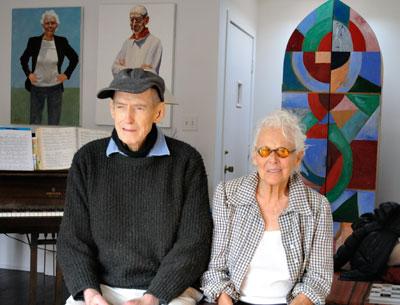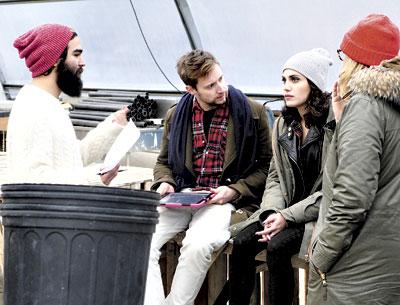Key Links in the East End Art Chain
Key Links in the East End Art Chain

In 1950, Connie Fox embarked on a 1,000-mile bicycle trip through Europe with two friends. On Nov. 1, she was in St. Peter’s Square in Rome when Pope Pius XII declared the Assumption of Mary as dogma. Bill King happened to be in the same place at the same time. They first met briefly during the 1960s at an art opening in Berkeley, Calif., but it was not until 1980, after Ms. Fox moved to East Hampton, that they found themselves together again, this time as fiddlers in Audrey Flack’s bluegrass band.
“I was second fiddle,” Mr. King told a visitor to their house on the day before Thanksgiving.
“He sang,” said Ms. Fox from the kitchen, where she was making tea, though he seemed reluctant to own up to that.
For the past 35 years, the couple has been as integral to the East Hampton art community as anybody, if not more so. What happened to bring the two artists together three decades after their orbits just missed each other in Rome?
Mr. King was born in Jacksonville, Fla., attended the University of Florida between 1942 and 1944, and then came to New York to study at Cooper Union, from which he graduated in 1948. His first solo show was in the city in 1954. By that time, his style was fully formed. “Odd, but true,” he said. “I was riding high. Same age, same everything as my contemporaries, except I didn’t have to work in a frame shop or as a museum guard because I was making a living as an artist.”
Born and raised in Fowler, Colo., Ms. Fox earned a B.F.A. from the University of Colorado before moving to Los Angeles to study at the Art Center, now known as the Art Center College of Design. “While there, I discovered a gallery that showed the Surrealists, and they just knocked me out. It was the real thing, and I knew it when I saw it.”
Ms. Fox was also affected by her time at the University of New Mexico, where she first met Elaine de Kooning, a longtime friend who had come there to teach. “That was my exposure to Abstract Expressionism. There was a version of it going on there and it was helped along when Elaine came. Other New Yorkers spent time there, so there was some actual interchange. There was high-level energy.” Ms. Fox, her first husband, Blair Boyd, and several others started the Albuquerque Modern Museum, which held classes and mounted exhibitions in an old bean factory.
Mr. King first came to East Hampton in 1959. “This was Valhalla for artists then. My wife at the time was teaching at the Dalton School, and one of her students was Dennis Mahoney. The Mahoneys had bought the Coast Guard barracks at Georgica Beach, which was then known as Coast Guard Beach. Barbara Mahoney ran it as a sort of boarding house. It was 400 feet to the ocean from the barn she rented us, it was 400 bucks a season, and the season was as long as we could stand it.” Mr. King came out during the summers, as did not only the New York artists, but artists from the West Coast as well.
“Word got around,” he continued, “and on any decent Sunday artists would come and put their blankets down and take out their Jack Daniel’s or whatever. A lot of the neighbors didn’t like the cars parked on their lawns, or people who were loud and drunk. The West Coast artists were more ‘presentable.’ ”
In the early 1970s, after he was divorced and lost his loft in Manhattan, Mr. King moved to East Hampton full time. Ms. Fox visited Ms. de Kooning several times during the 1960s and 1970s. “I remember going to the Elaine Benson Gallery and seeing what was going on.” By 1979, she was living outside Pittsburgh and her two children, Meagan and Brian, had entered college. “Elaine said to me, ‘You’ve got to move out here.’ Bob Dash was also an old friend of mine from the University of New Mexico. But I didn’t know much about the place.”
On one visit, Ms. de Kooning, whose studio was on Alewife Brook Road in the Northwest Woods, suggested they drive around the neighborhood. “We hadn’t driven very far when we came upon this property, which was for sale.” The owners, who were going through a bitter divorce, were eager to sell. “I liked it, but I wondered where I was going to paint. Elaine said, ‘Don’t worry about it. The whole house can be your studio.’ ”
Ms. Fox gave the couple a down payment and assumed the mortgage. “I never saw a banker or a lawyer. I made up my mind on the spot, and I’ve been here ever since.” The property, off Hand’s Creek Road, now includes separate studios for both Mr. King and Ms. Fox.
“My work blossomed when I moved here,” she said. “Part of it was building a big studio to work in, but I think I was ripe to expand and begin to really produce and find my own voice. I’ve lived in a lot of places where I was the only artist around, and being in an atmosphere where I wasn’t the only artist was a factor, too. Things just came together here, and I met Bill, and that was really nice.”
The two artists work independently of each other. “Connie might ask me to look at something, and I’ll look because I want to. As far as aesthetics are concerned, it might be more worthwhile for her to talk to other painters. All the time they’re talking about painting, I’m thinking about pieces of wood.”
In addition to producing and exhibiting their own work, they were involved from the beginning with LTV. Mr. King was one of the founders of the station, along with Fraser Dougherty, Jill Keefe, and Russell Stein. “I had an idea that if we had public access TV, we’d have a different kind of politics in this town,” he said.
While a board of directors wasn’t formed until 1984, the station’s archive goes back to 1980. “Jill Keefe and Bill King got wind of the fact that the town board was planning to sell property on Napeague for gambling casinos,” said Genie Henderson, the station’s archive librarian. “They were horrified. So Jill went to New York and took a course at the Alternate Media Center with George Stoney, who is regarded as the father of public-access television. The very first show we have is Bill and Barbara Hale standing on the dunes on Napeague and saying, ‘Save this beach.’ ”
Ms. Keefe also began to film town board meetings. “The board members were furious,” said Ms. Henderson. “Then Jill and Bill set up a viewing station in front of the post office so people could watch tapes of the meetings.”
The first recurring show Mr. King and Ms. Fox produced was “New York Review of Art,” which dates from 1982. “Their idea was to do a magazine show about the arts,” said Ms. Henderson. “They recorded a lot of local artists, but also went to galleries in New York.” Among the artists featured were Willem and Elaine de Kooning, each interviewed in his or her studio, Leon Polk Smith, George Segal, Philip Pearlstein, John Chamberlain, and Sol LeWitt, among others.
“Connie and Genie started the whole art thing at LTV,” said Mr. King, “and I thought it would be a nice chain: pick an artist, interview him uncut, show it on LTV, a rough-and-ready situation. That artist would choose another artist, and it would go on that way.”
The result was “Art Beat,” which ran intermittently between 1985 and 1987 and included Joan Semmel, David Slifka, Li Lan, Hedda Sterne, Ibram Lassaw, and Miriam Shapiro. Another Fox-King production for LTV featured three plays by Joe Pintauro, which were filmed in Ms. Fox’s studio. A list of the programs involving both artists reveals everything from “Bill King on East Hampton Politics” to Mr. King playing the accordion in the studio to Meagan Boyd, Ms. Fox’s daughter, and Scott Chaskey, her husband, reading from their poetry.
The Chaskeys, who live in Sag Harbor, were expected for Thanksgiving, along with Ms. Fox’s son, Brian Boyd, a teacher and writer, who was traveling with his family from Camden, Me., where he is co-founder and director of the Acadia Center for English Immersion.
Mr. King feels the art world changed in 1959 and became more gallery and money-oriented. “The main thing up to then — of course, there was a hierarchy — was that your value as an artist depended upon what other artists thought of you. Leo Castelli came out here, and Sam Kootz, another dealer, came around 1959 or 1960, and the whole feeling and focus and value changed.”
At this point, Ms. Fox, who had been working in the kitchen, brought Mr. King an egg and some toast. Before digging in, he said, “I once asked Connie if her first husband ever resented her being an artist. She said, ‘No, only when I began to get a career.’ ”


